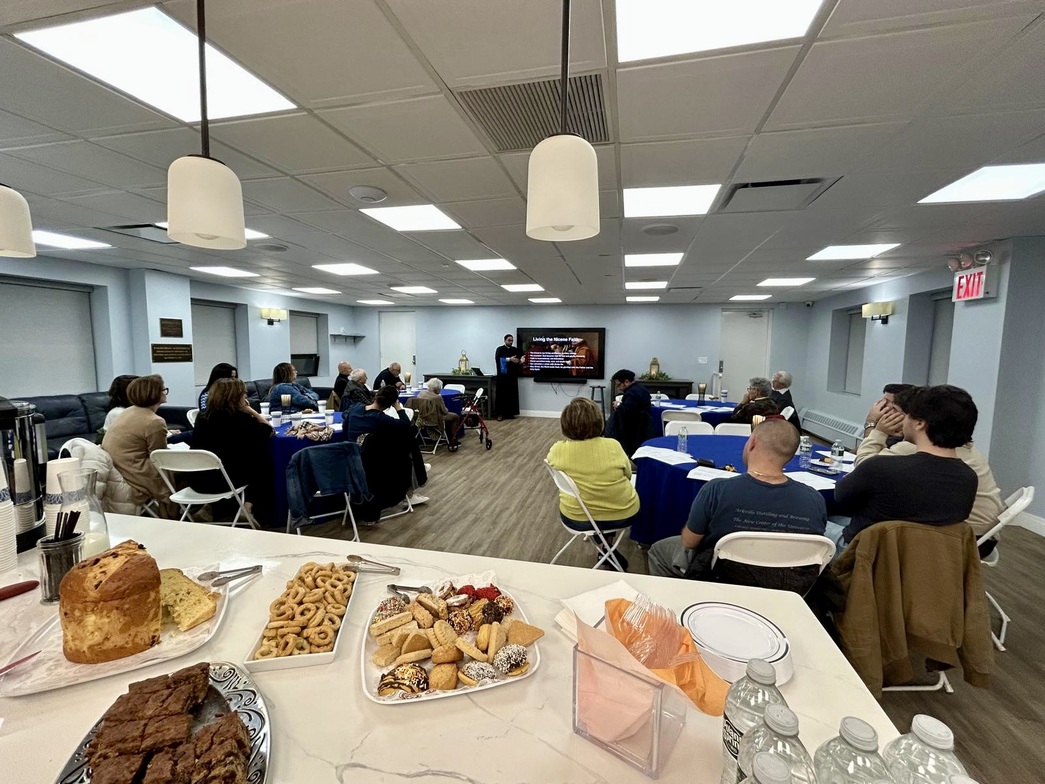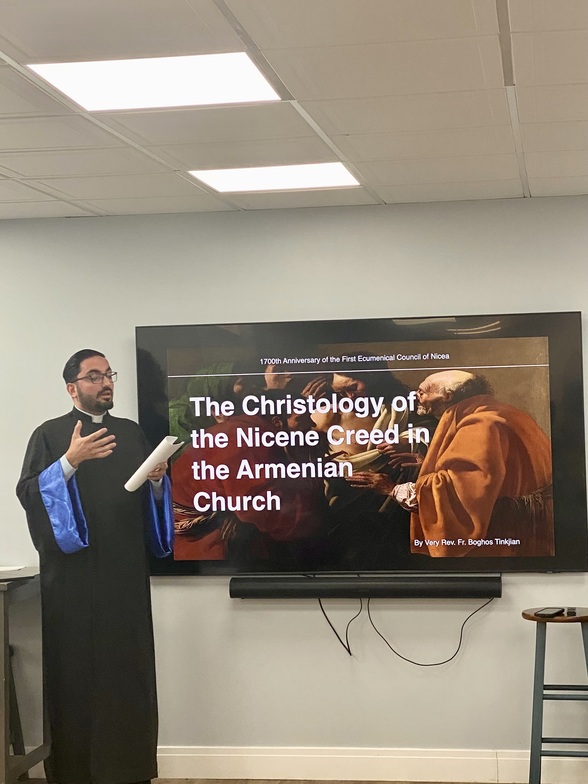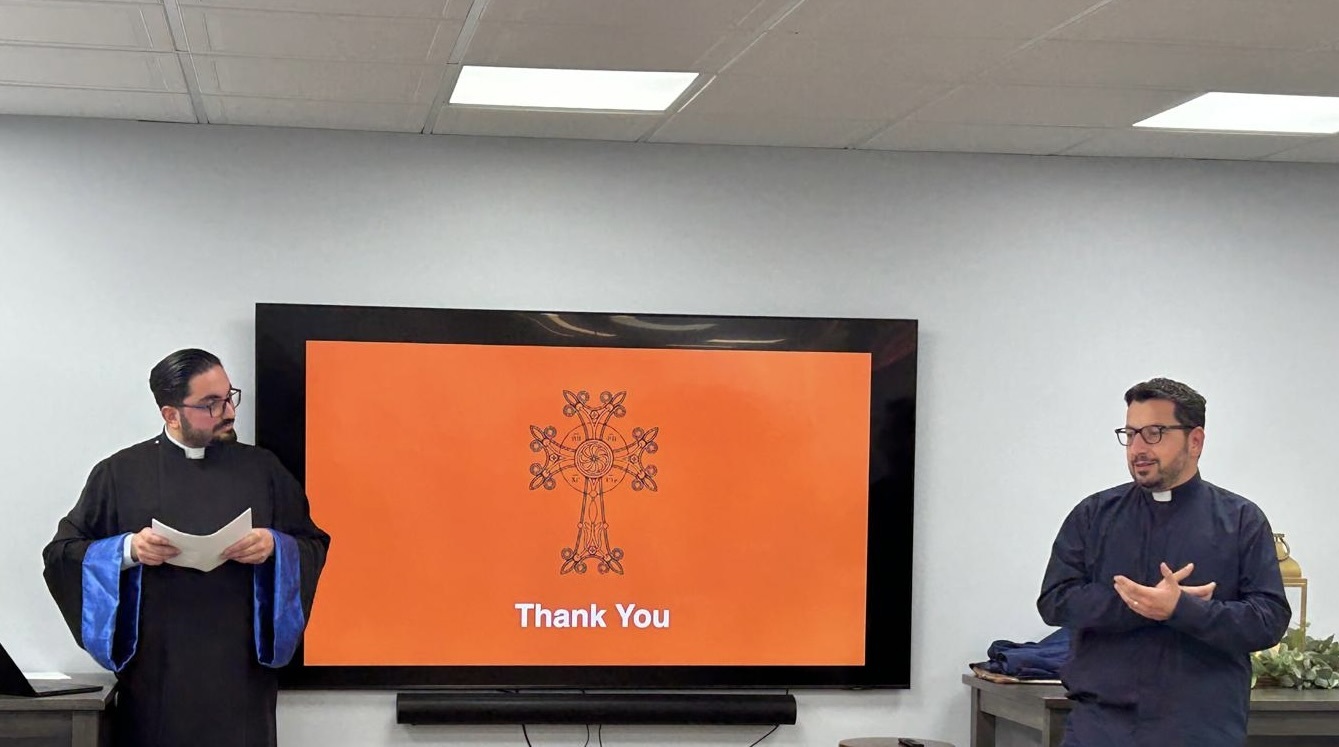Presented at St. Sarkis Church, Douglaston, NY — October 28, 2025
On Tuesday evening, October 28, 2025, the Pagoumian Hall of St. Sarkis Armenian Apostolic Church was filled with parishioners eager to continue their journey through the Nicene Creed’s 1700th anniversary series. The evening’s guest lecturer, Fr. Boghos Tinkjian, pastor of St. Gregory the Illuminator Church in Philadelphia, delivered an enlightening presentation titled “And We Believe in One Lord Jesus Christ.” This was the second installment of the three-part lecture series, “The Power of We Believe,” organized by St. Sarkis Church.
Introduction and Context
Fr. Nareg Terterian welcomed the audience, introducing Fr. Boghos as the former seminary dean and scholar of Christian doctrine. Driving from Philadelphia to attend the evening’s event, Fr. Boghos brought both pastoral warmth and theological depth to his lecture on the central portion of the Nicene Creed. This section proclaims faith in Jesus Christ.
This part of the Creed, he explained, is not only the longest but also the theological heart of the statement, as it affirms the divine and human natures of Christ. “The Christology of the Nicene Creed,” said Fr. Boghos, “is the core and the base of the whole Creed; it is the truth upon which the Christian faith stands.”
Christology and the Defense of Faith
Tracing the Creed’s origins to the Council of Nicaea (325 AD), Fr. Boghos explained how the early Church Fathers gathered to confront the Arian controversy, the teaching that Christ was a created being rather than fully divine. In response, the Church affirmed that the Son is “of one substance (homoousios) with the Father.” This declaration, he emphasized, is what preserves the truth of the Christian faith: that Jesus Christ is both fully God and fully man, eternal and uncreated.
He reminded the audience that the Nicene Creed was not written in isolation but forged through deep theological struggle to protect the integrity of the Gospel message. “Each phrase,” he said, “was chosen carefully and written to correct false teachings and preserve the truth revealed in Scripture.”
Line by Line: The Christology of the Creed
Fr. Boghos then guided attendees through a detailed exposition of the Creed’s Christological section, phrase by phrase. Beginning with “And in one Lord Jesus Christ, the Son of God, begotten of God the Father, only begotten, of the same substance of the Father,” he explained the key term “begotten, not made” as the Church’s defense against Arianism.
Using vivid imagery, he compared the Father and the Son to one continuous flame: “Just as one candle lights another without diminishing the first, the Son is light from light, God from God, true God from true God.”
He further unpacked the Creed’s declaration that “for us men and for our salvation He came down from heaven.” Here, the lecture moved from eternity to history, from who Christ is to what He has done. Through the incarnation, crucifixion, and resurrection, Christ bridges heaven and earth, taking on humanity fully and perfectly to redeem it. “What He did not assume,” said Fr. Boghos, quoting the Church Fathers, “He could not heal.”
Confronting Heresies and Upholding Truth
Throughout his lecture, Fr. Boghos presented a clear map of early Church heresies, from Arianism and Adoptionism to Docetism and Nestorianism, each countered by specific phrases in the Creed. Attendees received handouts that illustrated how each line of the Creed corresponds to scriptural affirmations and theological corrections.
He also touched upon the later controversies surrounding the Council of Chalcedon (451 AD). He explained the Armenian Church’s Miaphysite confession, affirming the one united nature of Christ as “without confusion, without change, without division, and without separation.” He illustrated this unity through a simple yet memorable analogy: “Like coffee and cream, distinct yet inseparable.”
Faith as a Living Confession
In conclusion, Fr. Boghos invited the audience to move beyond reciting the Creed as a mere liturgical routine and to live it as a personal confession of faith. “The Nicene Creed,” he said, “is not only a list of doctrines; it is our living faith, our thanksgiving, our song of love and salvation.”
Quoting St. Gregory of Narek, he ended with words that captured the spirit of the evening:
“You, the uncreated, entered the created, not in semblance but in truth, that you might raise the dust of our nature to the light of divinity.”
As the evening drew to a close, parishioners left with a renewed understanding that every word of the Creed, spoken during Badarak or whispered in prayer, connects them to the eternal mystery of faith: that Jesus Christ is true God and true man, our bridge to salvation.









